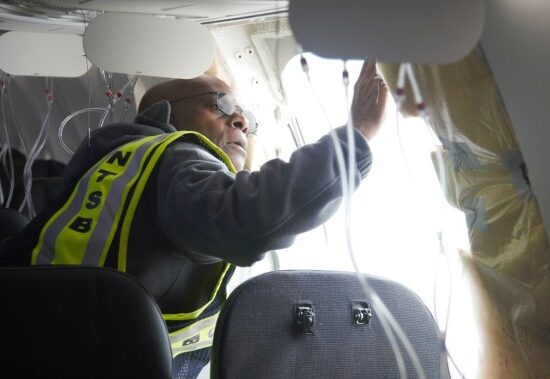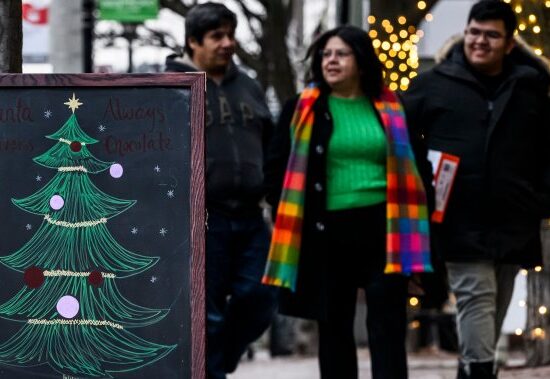British and Scottish officials on Saturday will attend the arrival of the Stone of Scone at Westminster Abbey ahead of King Charles III‘s coronation on May 6 — the latest chapter in a centuries-long history shared by the two countries.
Charles will become the latest in a long line of monarchs who have been crowned atop the stone, also known as the Stone of Destiny. Once a spoil of war, it is now seen as an ancient symbol not just of Scotland’s own monarchy, but also the oft-uneasy unity at the core of the United Kingdom that Charles now rules over.
“It’s a really iconic object,” Rachel Pickering, a historian and advisor for Historic Environment Scotland, told Global News.
Historians believe the 150-kilogram block of red sandstone dates back to the late ninth century, but Pickering notes its exact origins are “shrouded in mystery.”
Some legends date the stone back to biblical times, while others believe it came from the ancient Antonine Wall built by the Romans across Central Scotland in the second century.
Yet Pickering says it’s widely accepted that “the stone is from Scotland, and more specifically that it comes from the locality of Scone.”
A sword embedded in stone in front of a 19th-century Presbyterian mortuary chapel on Moot Hill at Scone Palace in Perth, Scotland, United Kingdom, Monday, Feb. 10, 2020. Scone Palace is a Category A listed historic house and 5 star tourism attraction near the village of Scone and the city of Perth, Scotland. Built of red sandstone with a castellated roof, it is one of the finest examples of late Georgian Gothic style in the United Kingdom. THE CANADIAN PRESS IMAGES/Jeff McIntosh.
Whatever its origins, the stone was used for centuries in the coronations of Scottish kings at Scone Palace on Moot Hill in Perthshire — hence the name Stone of Scone.
That was until 1296, when King Edward I of England seized the stone from Scotland during the First Scottish War of Independence, along with the royal regalia of John Balliol, King of Scots.
“They were essentially stripped from the Scottish king and taken to England as sort of war booty,” Pickering said.
Upon returning to England, Edward commissioned what is now known as the Coronation Chair, a wooden throne that housed the Stone of Scone directly under the seat. From then on, every subsequent English monarch was coronated on that chair in Westminster Abbey.
There is some doubt over whether the stone Edward brought back from England is the true Stone of Scone. Some legends say the monks of Scone Palace hid the real stone during the war and replaced it with a decoy taken from the grounds of the castle.
File photo dated 1910 of the Royal Throne in Westminster Abbey, with the Stone of Scone, also known as the Scottish Stone of Destiny. Issue date: Sunday September 11, 2022.
Despite two close calls — a bombing led by suffragettes in 1914, and its brief removal from Westminster Abbey amid German air raids during the Second World War — the Stone of Scone and the Coronation Chair remained undamaged for nearly 700 years.
But in 1950, four Scottish students aligned with the nationalist movement broke into the Abbey on Christmas Day and stole the stone.
“I have no idea how they managed it,” Pickering said. “It was such a great big heavy object!
“They apparently dragged it on a coat along the tiles through Westminster Abbey and hid it in the back of a Ford Anglia and then transported it back to Scotland.”
The statement signed by “The Guardians” which was sent with a photograph of a large stone, and which claims that the Stone of Scone – the Scottish Stone of Destiny – that was removed from Westminster Abbey on Christmas Day, 1950, was still in the hands of the “Scottish Guardians of the Stone.” It also purported that the stone recovered in 1951 was not the original, true stone.
During the robbery, the stone broke in two pieces, which some believe was actually caused by the earlier suffragette bombing. A stonemason repaired the stone once it was back in Scotland, and the now-intact stone was housed at Arbroath Abbey — where Scottish barons in 1320 asked the pope to formally recognize their independence amid English attempts at conquest.
Despite a massive British search, the stone was not recovered until April 1951. It was returned to Westminster Abbey and its place within the Coronation Chair, which was subsequently used during Queen Elizabeth II’s coronation two years later.
A stone – said to be the Scottish Stone of Destiny (Stone of Scone) but awaiting positive identification – was removed from Arbroath Abbey, Forfarshire, by police, who believed it to be the Stone of Scone stolen from Westminster Abbey.
In 1996, Elizabeth and the U.K. government agreed the stone should be returned to Scotland. A massive handover ceremony was held to watch the stone’s procession to Edinburgh Castle on St. Andrew’s Day — named for Scotland’s patron saint and a major national holiday.
“It was a really momentous occasion,” Pickering said. “It was a huge decision on the part of the U.K. government and a really symbolic political gesture for it to be returned home to Scotland.
“The event itself was a really big celebratory affair. There were over 10,000 people that lined the Royal Mile (in Edinburgh).”
** FILE ** Britain’s Prince Andrew, right, prepares to hand over the Royal Warrant to Scottish secretary Michael Forsyth, left, for the safe keeping of the Stone of Scone, during a ceremony in in the Great Hall of Edinburgh Castle, in this Saturday Nov. 30, 1996 file photo. The stone slab, weighing 458 pounds (208 kgs), was the coronation seat of Scottish kings until it was carried away to England as war booty by King Edward I in 1296, and placed in the coronation chair in London’s Westminster Abbey, where it has been involved in all coronations since. (AP Photo/Chris Bacon).
Since then, the stone has been housed in a high-security room along with the crown jewels of Scotland in Edinburgh Castle, with the understanding that it be brought back to London for future coronations.
On Saturday, Charles will become the first British monarch coronated in the (temporary) presence of a Stone of Scone that officially resides in Scotland.
Amid continued debates over that country’s independence from the U.K. and the future of the Commonwealth at large, Pickering says the coronation is a chance to teach people about Scottish history and a piece of Scottish lore that historians are still learning about.
She says new scientific analyses, including X-ray fluorescence imaging, have uncovered what could be Roman numerals etched into the stone, as well as traces of other metals and materials that could answer questions about its origins.
“We don’t really have all the answers yet,” she said.
The Stone of Destiny, which is also known as the Stone of Scone, lies in Edinburgh Castle before its onward transportation to be placed beneath the Coronation Chair at Westminster Abbey for the coronation of King Charles III. The stone is returning to England for the first time since 1996 to play a key part in the coronation ceremony. Picture date: Thursday April 27, 2023.
© 2023 Global News, a division of Corus Entertainment Inc.














